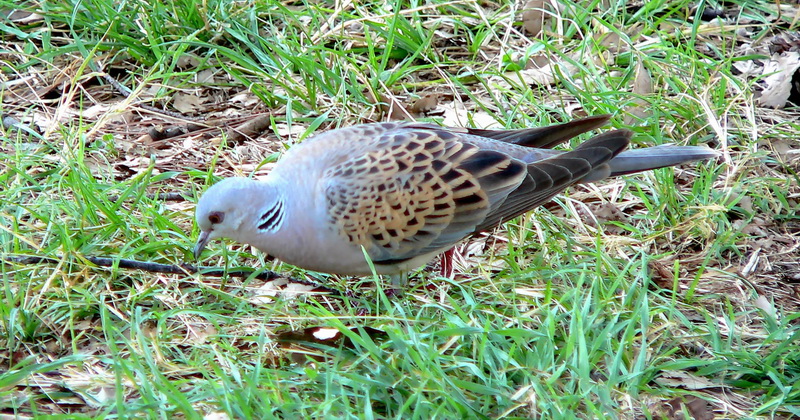| 새로운 사진 | 신문속의 동물소식 | 신기한 동물이야기 | 동물의 소리 | 동물동화상 | 사진 올리기 | 사진 저작권 | English |
|---|
| 재미있는 동물사진 | 괴수/괴어/엽기 동물사진 | 동물이름사전 | 동물목록 | 바깥고리 | 창고입구 | 똑똑누리집 |
|---|
| 이미지 정보 | Original File Name: European Turtle Dove (Streptopelia turtur) 01.jpg Resolution: 800x420 File Size: 285493 Bytes Date: 2006:08:26 17:47:19 Camera: DMC-FZ20 (Panasonic) F number: f/2.8 Exposure: 10/500 sec Focal Length: 720/10 Upload Time: 2007:10:30 16:23:41 | |
| 올린이 | 이름 (메일주소): Unknown | |
| 사진 제목 | European Turtle Dove (Streptopelia turtur) - Wiki | |
 |
| Email : 카드 | 올린이 | 운영자 사진삭제 정보수정 Admin |
| 설명 | European Turtle Dove (Streptopelia turtur) - Wiki
Turtle Dove
The Turtle Dove (Streptopelia turtur) is a member of the bird family Columbidae, which includes the doves and pigeons. It is a migratory species with a western Palearctic range, including Turkey and north Africa, though it is rare in northern Scandinavia and Russia; it winters in southern Africa. In the British Isles, France, and elsewhere in northwestern Europe it is in severe population decline. This is partly because changed farming practices mean that the weed seeds and shoots on which it feeds, especially Fumitory, are scarcer, and partly due to shooting of birds on migration in Mediterranean countries. Smaller and slighter in build than other doves, the Turtle Dove may be recognised by its browner colour, and the black and white striped patch on the side of its neck, but it is its tail that catches the eye when it flies from the observer; it is wedge shaped, with a dark centre and white borders and tips. When viewed from below this pattern, owing to the white under tail coverts obscuring the dark bases, is a blackish chevron on a white ground. This is noticeable when the bird stoops to drink, raising its spread tail. The mature bird has the head, neck, flanks, and rump blue grey, and the wings cinnamon, mottled with black. The breast is vinaceous, the abdomen and under tail coverts are white. The bill is black, the legs and eyerims are red. The black and white patch on the side of the neck is absent in the browner and duller juvenile bird, which also has the legs brown. The Turtle Dove, one of the latest migrants, rarely appears in Northern Europe before the end of April, returning south again in September. It is a bird of open rather than dense woodlands, and frequently feeds on the ground. It will occasionally nest in large gardens, but is usually extremely timid, probably due to the heavy hunting pressure it faces on migration. The flight is often described as arrowy, but is not remarkably swift. The nuptial flight, high and circling, is rather like that of the Wood Pigeon, but the undulations are less decided; it is accompanied by the whipcrack of the downward flicked wings. The arrival in spring is heralded by its purring song, a rather deep, vibrating “turrr, turrr”, from which the bird's name is derived. The nest is even more flimsy looking than that of the Wood Pigeon, being built of more slender twigs, usually at no great height, in a tree or old untrimmed hedge. The two white eggs are laid late in May or in June, often with a second clutch in July or August. A few other doves in the same genus are also called turtle doves: the Asian Oriental Turtle Dove S. orientalis and Spotted Turtle Dove S. chinensis. the African Dusky Turtle Dove S. lugens and Laughing Dove S. senegalensis. S. senegalensis and S. chinensis have been introduced into Australia. A New World dove of similar appearance and behavior to that of the Turtle Dove is the Mourning Dove. ... http://en.wikipedia.org/wiki/Turtle_Dove
| |||
| 저작권 정보 | 사진의 저작권은 원저작자에게 있습니다. 동물그림창고는 동물관련 사진을 전시할 수 있는 공간만을 제공합니다.사진을 사용하고자 할 경우에는 저작권자와 협의하시기 바랍니다. |
|
|
|
| |||||||
| CopyLeft © since 1995, 동물그림창고. All rights may be reserved. | ||||||||
Stats